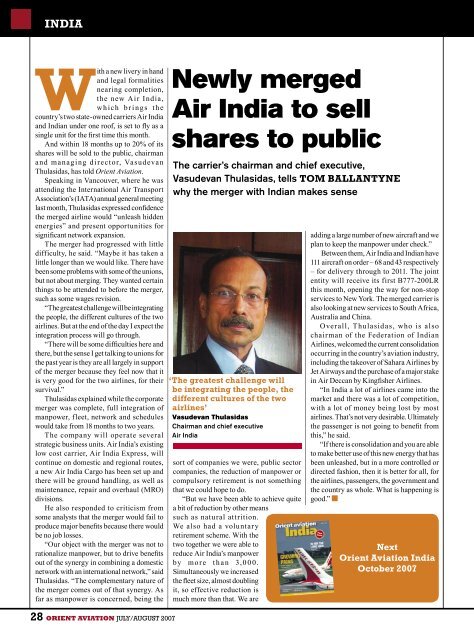Malaysia Airlines - Orient Aviation
Malaysia Airlines - Orient Aviation
Malaysia Airlines - Orient Aviation
Create successful ePaper yourself
Turn your PDF publications into a flip-book with our unique Google optimized e-Paper software.
INDIA<br />
With a new livery in hand<br />
and legal formalities<br />
nearing completion,<br />
the new Air India,<br />
wh ich br i ngs t he<br />
country’s two state-owned carriers Air India<br />
and Indian under one roof, is set to fly as a<br />
single unit for the first time this month.<br />
And within 18 months up to 20% of its<br />
shares will be sold to the public, chairman<br />
and managing director, Vasudevan<br />
Thulasidas, has told <strong>Orient</strong> <strong>Aviation</strong>.<br />
Speaking in Vancouver, where he was<br />
attending the International Air Transport<br />
Association’s (IATA) annual general meeting<br />
last month, Thulasidas expressed confidence<br />
the merged airline would “unleash hidden<br />
energies” and present opportunities for<br />
significant network expansion.<br />
The merger had progressed with little<br />
difficulty, he said. “Maybe it has taken a<br />
little longer than we would like. There have<br />
been some problems with some of the unions,<br />
but not about merging. They wanted certain<br />
things to be attended to before the merger,<br />
such as some wages revision.<br />
“The greatest challenge will be integrating<br />
the people, the different cultures of the two<br />
airlines. But at the end of the day I expect the<br />
integration process will go through.<br />
“There will be some difficulties here and<br />
there, but the sense I get talking to unions for<br />
the past year is they are all largely in support<br />
of the merger because they feel now that it<br />
is very good for the two airlines, for their<br />
survival.”<br />
Thulasidas explained while the corporate<br />
merger was complete, full integration of<br />
manpower, fleet, network and schedules<br />
would take from 18 months to two years.<br />
The company will operate several<br />
strategic business units. Air India’s existing<br />
low cost carrier, Air India Express, will<br />
continue on domestic and regional routes,<br />
a new Air India Cargo has been set up and<br />
there will be ground handling, as well as<br />
maintenance, repair and overhaul (MRO)<br />
divisions.<br />
He also responded to criticism from<br />
some analysts that the merger would fail to<br />
produce major benefits because there would<br />
be no job losses.<br />
“Our object with the merger was not to<br />
rationalize manpower, but to drive benefits<br />
out of the synergy in combining a domestic<br />
network with an international network,” said<br />
Thulasidas. “The complementary nature of<br />
the merger comes out of that synergy. As<br />
far as manpower is concerned, being the<br />
Newly merged<br />
Air India to sell<br />
shares to public<br />
The carrier’s chairman and chief executive,<br />
Vasudevan Thulasidas, tells TOM BALLANTYNE<br />
why the merger with Indian makes sense<br />
‘The greatest challenge will<br />
be integrating the people, the<br />
different cultures of the two<br />
airlines’<br />
Vasudevan Thulasidas<br />
Chairman and chief executive<br />
Air India<br />
sort of companies we were, public sector<br />
companies, the reduction of manpower or<br />
compulsory retirement is not something<br />
that we could hope to do.<br />
“But we have been able to achieve quite<br />
a bit of reduction by other means<br />
such as natural attrition.<br />
We also had a voluntary<br />
retirement scheme. With the<br />
two together we were able to<br />
reduce Air India’s manpower<br />
by more t h a n 3,0 0 0.<br />
Simultaneously we increased<br />
the fleet size, almost doubling<br />
it, so effective reduction is<br />
much more than that. We are<br />
adding a large number of new aircraft and we<br />
plan to keep the manpower under check.”<br />
Between them, Air India and Indian have<br />
111 aircraft on order – 68 and 43 respectively<br />
– for delivery through to 2011. The joint<br />
entity will receive its first B777-200LR<br />
this month, opening the way for non-stop<br />
services to New York. The merged carrier is<br />
also looking at new services to South Africa,<br />
Australia and China.<br />
Overall, Thulasidas, who is also<br />
chairman of the Federation of Indian<br />
<strong>Airlines</strong>, welcomed the current consolidation<br />
occurring in the country’s aviation industry,<br />
including the takeover of Sahara <strong>Airlines</strong> by<br />
Jet Airways and the purchase of a major stake<br />
in Air Deccan by Kingfisher <strong>Airlines</strong>.<br />
“In India a lot of airlines came into the<br />
market and there was a lot of competition,<br />
with a lot of money being lost by most<br />
airlines. That’s not very desirable. Ultimately<br />
the passenger is not going to benefit from<br />
this,” he said.<br />
“If there is consolidation and you are able<br />
to make better use of this new energy that has<br />
been unleashed, but in a more controlled or<br />
directed fashion, then it is better for all, for<br />
the airlines, passengers, the government and<br />
the country as whole. What is happening is<br />
good.”<br />
Next<br />
<strong>Orient</strong> <strong>Aviation</strong> India<br />
October 2007<br />
28 ORIENT AVIATION JULY/AUGUST 2007








![OAMag-V7N4-Cover [Converted] - Orient Aviation](https://img.yumpu.com/48598575/1/190x255/oamag-v7n4-cover-converted-orient-aviation.jpg?quality=85)








